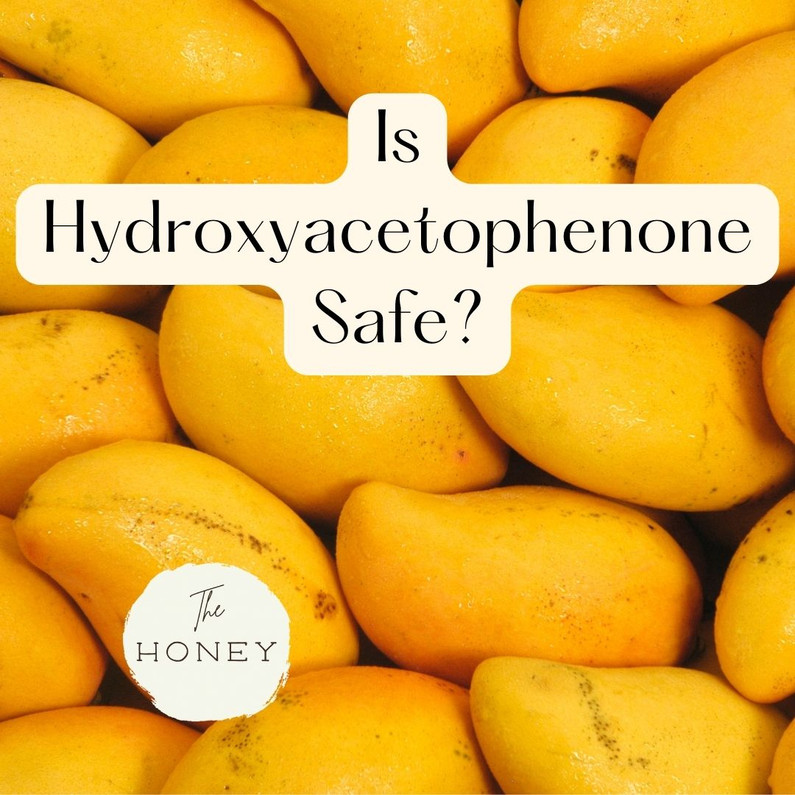Is Hydroxyacetophenone Safe?
Is hydroxyacetophenone safe? Let's look at the available data.
The EWG Cosmetics Database gives hydroxyacetophenone a "1" risk score, implying that it's safe. However the name of this chemical gave me pause. "Phenone" usually indicates that it's what's called an "aromatic" compound containing a benzene ring. And indeed, doing some digging, I found the chemical structure and it does indeed contain a benzene ring. That warranted further investigation, as some of these compounds can display hormonal activity due to their chemical similarity to estrogen.
What is hydroxyacetophenone?
 Hydroxyacetophenone on a chemical level is a monohydroxyacetophenone. That means it has an acetyl group, a phenyl group, and a hydroxy group.
Hydroxyacetophenone on a chemical level is a monohydroxyacetophenone. That means it has an acetyl group, a phenyl group, and a hydroxy group.
Hydroxyacetophenone is used as a flavoring agent. It naturally occurs in cloudberry, coffee, mango, sherry, certain fungi, pine needles, and in trace amounts in cranberry. However, most commercially available hydroxyacetophenone is synthetically-produced. It has a floral aroma.
According to one patent filing, it's created by combining phenol with acetic acid or acetic anhydride in the presence of hydrogen fluoride.
Is Hydroxyacetophenone Safe?
Animal studies have found the ingredient to have fairly low toxicity, with just some cases of skin irritation or skin sensitization found. However, I found a discussion between the scientists on the Cosmetics Ingredient Review board as they were trying to figure out why it can irritate skin.

Boom. There it is. Para-hydroxybenzoic acid. Does that chemical name sound familiar? Para-hydroxybenzoic acid is the basis for the preservatives we know as parabens, which do have xenoestrogenic activity. (Interacting with estrogen receptors and enzymes and stimulating them in certain ways.) Para-hydroxybenzoic acid has been found to display estrogenic activity.
Further digging led me to an article from 2000 wherein hydroxyacetophenone was identified as an estrogenic chemical. The full article isn't available to the public, so here is a screen shot showing the list of estrogenic chemicals the researchers identified. This is the list of chemicals that displayed estrogenic activity in yeast assays after testing 500 different chemicals.

Most animal studies on hydroxyacetophenone were administered by injection or orally. I have been unable to locate any in vivo studies that looked at dermal application to study absorption and skin metabolism. Many times substances applied to skin are metabolized differently than those ingested.
Hydroxyacetophenone is classified as a developmental toxin, however, researchers point out that in low as used in the fragrance industry concentrations the chemical doesn't display this toxicity.
Now it Gets Confusing
As I continued to research to find out is hydroxyacetophenone safe, I found this study, that found 4-hydroxyacetophenone (the isomer we're referring to in this article) actually has anti-cancer activity against colon cancer. And another study showing promise as a treatment against pancreatic cancer. And finally, this study that found it may help reduce overactive immune responses. Even though other studies have identified it as a contact allergen.
Bottom Line:
Is hydroxyacetophenone safe? There's a lot we don't know about how the body reacts to and metabolizes this chemical. Hydroxyacetophenone should be studied further for estrogenic activity, metabolism on skin, and interaction with estrogen receptors and related enzymes. Naturally-occurring hydroxyacetophenone (like found in mangoes) is unlikely to be harmful and may even be beneficial, especially in the presence of other phyto compounds. However higher concentrations of the synthesized material should be viewed with caution until we have more data.
Recent Posts
-
Vegetable Emulsifying Wax NF
What is Vegetable Emulsifying Wax NF?Vegetable Emulsifying Wax NF is a blend of chemicals, namely ce …16th Aug 2024 -
Tocopherol vs. Tocopheryl Acetate: What's the Difference?
Let's look at the differences between tocopherol vs tocopheryl acetateThere are two forms of vitamin …16th Jul 2024 -
Are Essential Oils Toxic?
The following comment was made in a Facebook group for which I'm an admin. It was a lot to unpack in …16th Jul 2024

